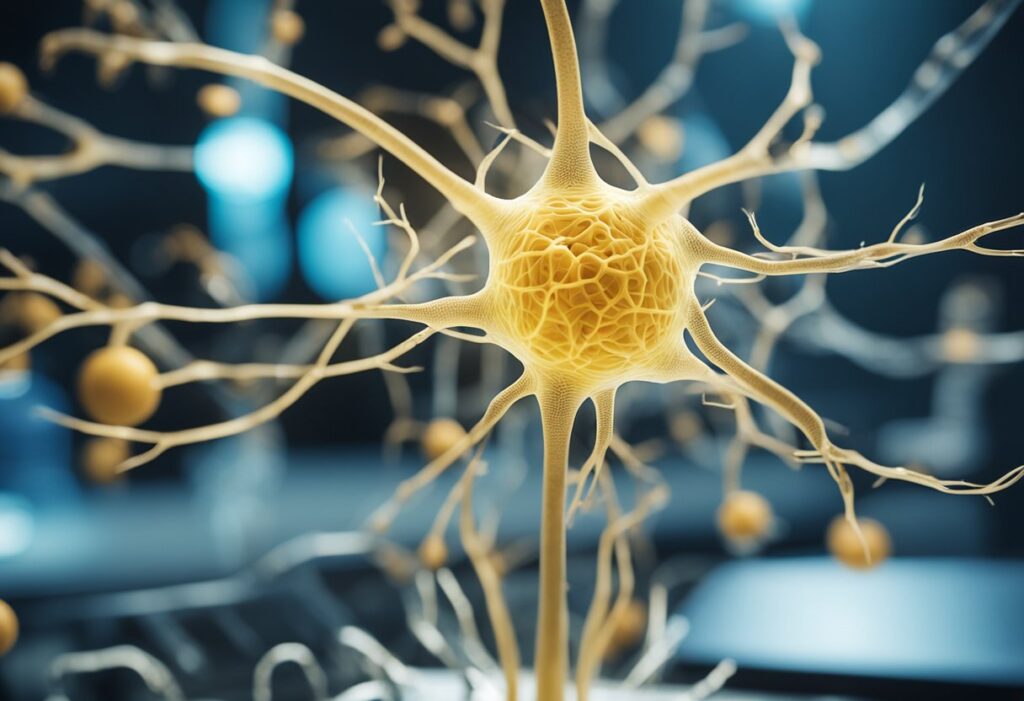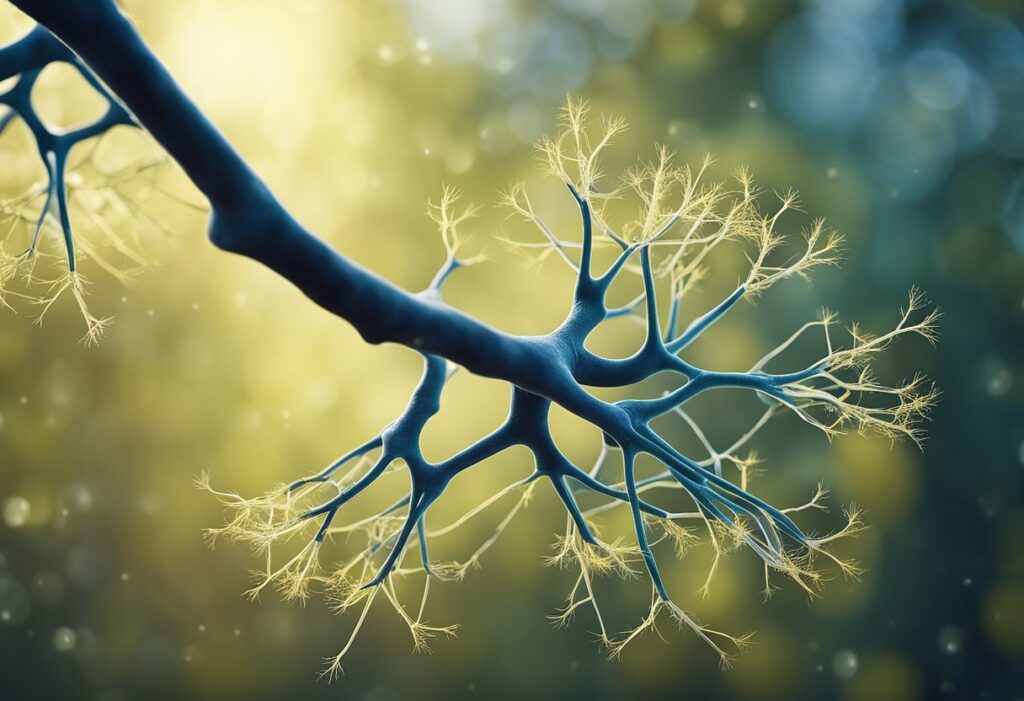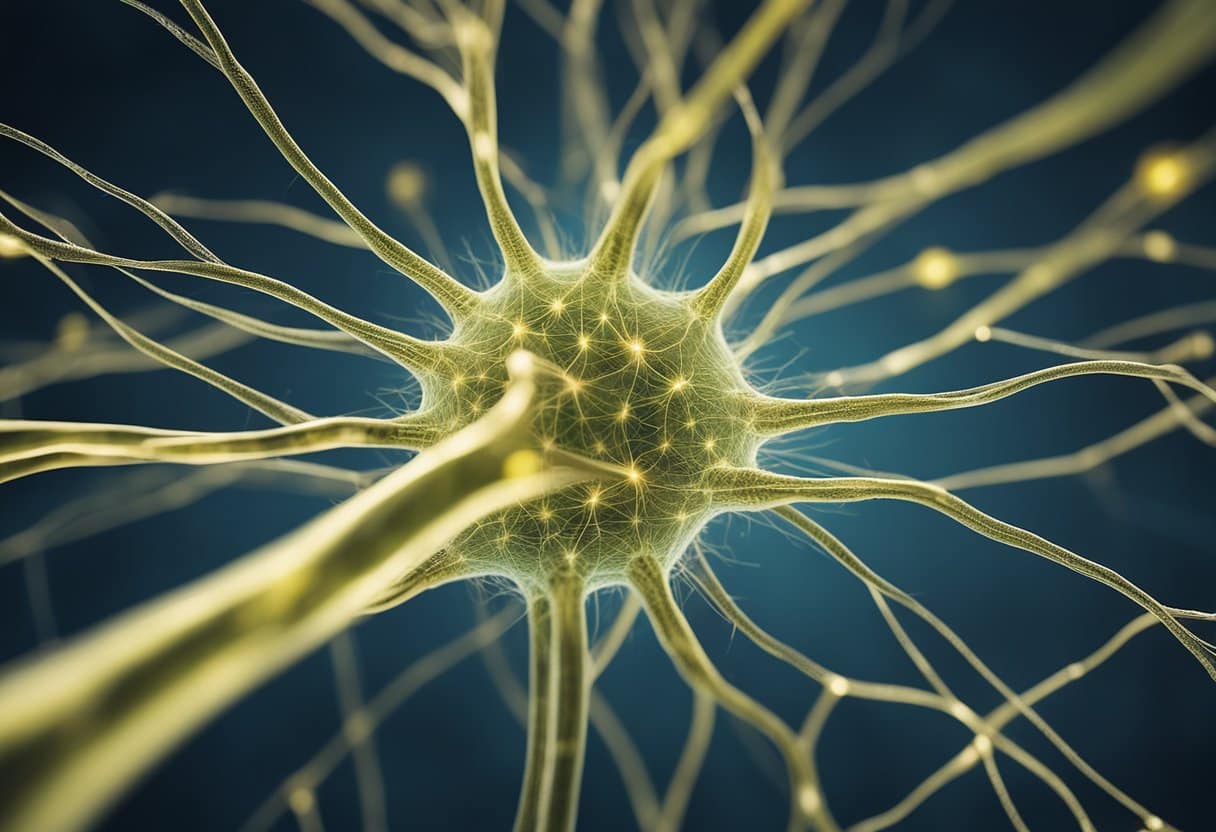Nerve regeneration is a crucial aspect of the body’s healing processes, particularly in the context of damage to the nervous system. The nervous system comprises the central nervous system (CNS) and the peripheral nervous system (PNS), both serving distinct but interconnected roles in the body’s overall function. The ability of cells within these systems to regenerate and restore their function following injury is a topic of considerable significance, as these processes can have a profound impact on an individual’s quality of life and long-term health prospects.
The neuroregenerative mechanisms operating within the nervous system can vary depending on the specific type of damage and location within the CNS or PNS. Generally, PNS cells exhibit a greater capacity to repair themselves compared to CNS cells. Factors that could influence regeneration may include the generation of new neurons, glia, axons, myelin, or synapses. Understanding these mechanisms is essential for advancing the development of potential therapies that can enhance or even restore lost functions in the nervous system.
Research into nerve regeneration is constantly evolving, and organizations like Mayo Clinic are at the forefront of exploring novel approaches to enhance the body’s natural regenerative processes. The advancement of these therapeutic techniques could ultimately pave the way for better treatment options for neurological injuries and conditions in the future.
Understanding Nerve Damage

Types of Nerve Injury
Nerve injuries can be broadly classified into two categories: central nervous system (CNS) and peripheral nerve injuries. The CNS consists of the brain and spinal cord, which are responsible for higher-level functions and communication between the brain and the periphery. Peripheral nerve injuries involve damage to the nerves that transmit signals between the CNS and the rest of the body.
Mechanisms of Nerve Injury
Nerve damage can occur due to various reasons, including:
- Trauma: Physical impact or compression can cause damage to nerves. This may result from accidents, falls, or surgical procedures that directly affect the nerves.
- Disease: Certain diseases, such as multiple sclerosis and Parkinson’s disease, can cause nerve degeneration in the CNS. In the peripheral nervous system, diabetes can lead to peripheral neuropathy.
- Toxins: Exposure to toxic substances like heavy metals, alcohol, or chemotherapy drugs can also cause nerve damage.
Consequences of Nerve Damage
Depending on the severity and location of the nerve damage, the consequences can range from mild to severe. Some possible outcomes include:
- Loss of sensation: Damaged nerves may lose their ability to transmit sensory information, leading to numbness or reduced sensitivity in the affected areas.
- Impaired movement: Damage to motor nerves can result in muscle weakness, paralysis, or uncoordinated movements.
- Chronic pain: Some nerve injuries may lead to persistent, chronic pain that can be difficult to manage.
- Reduced function: In the case of CNS damage, more severe consequences may involve cognitive impairments, memory loss, or difficulties with speech and language.
The process of nerve regeneration and repair can be complicated and may vary depending on the type of injury, the location of the damage, and the individual’s overall health. In some cases, a complete recovery is possible, while in others, the damage may be permanent. Understanding the different types of nerve injuries, the mechanisms by which they occur, and their consequences is essential for developing effective treatment strategies and improving health outcomes.
The Biology Behind Nerve Repair
Cellular and Molecular Basis
During nerve regeneration, a series of cellular and molecular events occur following peripheral nerve injury. Neurons, glia, and other cells coordinate a complex process that includes inflammation, Wallerian degeneration, axonal regeneration, and reinnervation of target organs. Various growth factors play essential roles in promoting nerve regeneration and functional recovery.
Role of Schwann Cells
Schwann cells are crucial glial cells in the peripheral nervous system, playing a vital role in nerve regeneration. These cells support axonal growth by producing growth factors, participating in myelin formation, and guiding regenerating axons towards their target organs. Schwann cells also help create a favorable environment for axonal regeneration by clearing debris from the damaged site and modulating inflammation.
Axonal Regeneration Process
Axonal regeneration is a multi-step process that begins with Wallerian degeneration, which involves the breakdown of the distal segment of the injured axon and the removal of its myelin sheath by Schwann cells. Regenerating axons then grow by extending the proximal stump and following guidance cues provided by Schwann cells. During this process, axons also encounter various obstacles, including scar tissue and inhibitory factors.
Ultimately, successful axonal regeneration relies heavily on the precise coordination of these cellular and molecular events. Recent research is increasingly focusing on understanding the neurobiology of peripheral nerve injury, regeneration, and functional recovery, which could lead to improved treatments for patients who have sustained injuries to large nerve trunks such as the brachial plexus.
Key Factors Influencing Nerve Regeneration

Intrinsic Factors
Intrinsic factors play a critical role in nerve regeneration, such as the involvement of cytokines and neurotrophins. These contribute to the overall process of axon growth and nerve repair. Cytokines are small proteins that facilitate cell-to-cell communication during immune responses and regulate the initiation and duration of inflammation. On the other hand, neurotrophins are a family of proteins that promote the survival, development, and function of neurons (PubMed).
Another important aspect within intrinsic factors is the growth cone, a structure at the tip of extending axons playing a crucial role in guiding neurons towards their target destinations. For successful nerve regeneration, the growth cone helps in pathfinding and developing accurate connections between nerve cells and their targets.
Extrinsic Factors
The extrinsic factors encompass the non-neuronal cells and their contributions to nerve regeneration. One of the key players in this process is the Schwann cell, which creates a supportive microenvironment for peripheral nerve regeneration and maturation (PMC). Moreover, stem cells and tissue engineering offer promising potential for nerve repair and functional restoration after injury. Through the use of stem cells and scaffolding structures, in vitro nerve guidance conduits are developed to aid the process of nerve regeneration.
Additionally, the immune system plays a crucial role in the overall process of recovery by clearing debris, releasing growth factors, and modulating the inflammatory response. A well-regulated immune system allows the delicate balance required for effective regeneration of damaged nerves.
Influence of Age and Gender
Age and gender play a critical role in nerve regeneration. As individuals age, their ability to regenerate nerves gradually declines. This is partly due to the weakening of the immune system, reduced neuronal plasticity, and a decline in the regenerative capacity of neurons (PMC).
Gender may also have a significant influence on nerve regeneration. Studies have shown that certain hormones, such as estrogen, can exert neuroprotective effects and enhance nerve regeneration. Understanding these hormonal interactions can be pivotal for developing improved treatments for nerve damage and ensuring better recovery outcomes.
In summary, nerve regeneration depends on a complex interplay of factors encompassing both intrinsic and extrinsic elements. These factors contribute to the overall success of nerve repair, from the regulation of inflammation to the support of neuronal growth and the influence of age and gender. Consequently, gaining a deeper understanding of these factors has the potential to advance treatment options for those suffering from nerve damage and enhance their quality of life.
Clinical Approaches to Nerve Repair
Nerve repair is a vital aspect of treatment for patients with peripheral nerve injuries. Neurologists and surgeons employ various techniques and strategies to aid in the recovery and regrowth of damaged nerves. This section explores various clinical approaches to nerve repair, including surgical techniques, nerve grafting and conduits, and pharmacological treatments.
Surgical Techniques
Surgical intervention is often necessary in cases of severe nerve damage, such as neurotmesis, where nerve fibers and their surrounding connective tissues are completely severed. Nerve surgery helps to reestablish the connection between the severed nerve ends to promote nerve regeneration and functional recovery. A few common surgical techniques include:
- Direct Nerve Repair: The simplest method of nerve surgery involves directly suturing the nerve ends together under a microscope. This is usually done in cases where minimal nerve gap exists.
- Nerve Grafting: When the nerve gap is too large, nerve grafts are employed by harvesting a segment of nerve from another part of the patient’s body to bridge the gap. This facilitates nerve regeneration across the repair site.
- Nerve Transfers: In certain cases, nerves from a nearby, less critical muscle are transferred to the target muscle to restore function, bypassing the damaged segment of the nerve entirely.
Research has also shown that electrical stimulation and gene therapy can enhance axonal regeneration across the repair site.
Nerve Grafting and Conduits
When direct nerve repair is not viable due to the size of the nerve gap, nerve grafting and conduits come into play. Nerve grafts, usually sourced from a less critical nerve in the patient’s body, are placed between the severed nerve ends, acting as a bridge for nerve regeneration.
Conversely, nerve conduits can be made from biological or synthetic materials to guide and protect regenerating axons. These tubes are placed around the damaged nerve, creating a physical structure that directs the regrowth of axons from the proximal to the distal end. Recent advances have explored the bioengineering of nerve conduits with pluripotent stem cells, smart exosomes, and pharmacological agents, further enhancing nerve regeneration.
Pharmacological Treatments
Pharmacological treatments can support nerve repair by mitigating inflammation and promoting nerve regeneration. Some common pharmacological treatments include:
- Tacrolimus: An immunosuppressive drug that, in recent studies, has shown to be effective in promoting nerve regeneration.
- Anti-inflammatory drugs: These medications help reduce inflammation and swelling at the site of injury, promoting a favorable environment for nerve regeneration.
- Neurotrophic factors: Substances that encourage nerve growth and regeneration by stimulating the growth and survival of nerve cells.
Pharmacological treatments can be used in conjunction with surgical techniques to expedite nerve recovery and improve overall outcomes in patients with peripheral nerve injuries.
Innovative Therapies in Nervous System Repair
Stem Cell Therapy
Stem cell therapy is a promising approach to promote nerve regeneration. It uses specialized cells, known as stem cells, that have the potential to develop into various cell types, including neurons. These cells can be used in both in vivo and in vitro applications to repair damaged nerves in the peripheral nervous system. The use of stem cell therapy for neuroregeneration is being explored at the Mayo Clinic Center for Regenerative Biotherapeutics.
Gene Therapy
Gene therapy is another innovative technique being used for nervous system repair. This approach involves modifying, replacing, or adding specific genes within an individual’s cells to promote the regeneration of damaged neurons. Gene therapy can target specific nerve cells, allowing for the restoration of lost functions, such as motor, sensory, and autonomic abilities.
Biomaterials and Bioengineering
The field of biomaterials and bioengineering is playing a crucial role in the development of new treatments for nerve regeneration. Advances in tissue engineering have led to the development of biomaterial scaffolds that can imitate the extracellular matrix, providing a supportive environment for nerve growth. These scaffolds can be designed to facilitate the growth of neurons and promote peripheral nerve regeneration.
Scientists are working on various strategies, such as 3D printing and the use of nanomaterials, to create customized nerve guidance channels. These channels can help guide the growth of nerve fibers, improving the chances of successful regeneration. The combination of biomaterials, bioengineering, and other innovative therapies will be instrumental in developing effective treatments for patients suffering from nerve damage or disease.
Advancements in Nerve Regeneration Research
Role of Animal Models
Animal models have played a significant role in understanding the mechanisms behind nerve regeneration due to their similar anatomical structures and functional features to humans. These models have been pivotal in identifying the various molecular and cellular components involved in nerve repair, with innovations driven by factors such as nerve growth factor (NGF) 1. Researchers have utilized rodents, avian models, and other species to analyze nerve regeneration and develop potential therapies.
Nerve Regeneration in the Central Nervous System
In the context of the central nervous system (CNS), nerve regeneration is a more complex process than in the peripheral nervous system (PNS). In the CNS, the axonal growth is often inhibited by myelin debris and a glial scar, hindering the reconnection of severed nerves. However, recent studies have observed progress in promoting nerve regeneration within the CNS by targeting certain growth factors like brain-derived neurotrophic factor (BDNF) and vascular endothelial growth factor (VEGF). These growth factors stimulate axon growth, support the growth cone, and help modulate essential signaling pathways in the nerve repair process 1.
Emerging Molecular Targets
The understanding of molecular mechanisms involved in nerve regeneration is still growing, and several emerging targets have surfaced in recent years. Particular focus has been given to signaling pathways that aid in axonal growth and guidance, such as the Rho/ROCK pathway or the BMP2/Smad1/5/8 pathway. Researchers are also exploring the application of gene therapy to enhance the expression of axonal growth-promoting factors like BDNF and VEGF in the injured tissue, thereby accelerating nerve repair. These advancements and discoveries in nerve regeneration research continue to pave the way for improved treatments in both peripheral and central nerve injuries.
Frequently Asked Questions
What dietary choices can support nerve repair and health?
A balanced diet, rich in essential nutrients, can support nerve health. Incorporating foods high in omega-3 fatty acids, B vitamins, vitamin E, vitamin D, and magnesium may promote nerve repair and function. Fatty fish, nuts, seeds, leafy greens, whole grains, and lean protein sources are all beneficial for maintaining a healthy nervous system.
Which supplements may aid in the regeneration of nerves?
While it is ideal to receive necessary nutrients through diet, supplements may be helpful when dietary intake is inadequate. Common supplements for nerve support include B-complex vitamins, alpha-lipoic acid, acetyl-L-carnitine, omega-3 fatty acids, magnesium, and vitamin E. However, it is essential to consult with a healthcare professional before starting any supplementation regimen.
What indicators suggest that nerve regeneration is occurring?
Signs of nerve regeneration may include a gradual improvement in symptoms such as numbness, tingling, pain, and weakness in the affected area. Additionally, increased sensitivity or feeling in previously numb areas may indicate nerve healing. Keep in mind that nerve regeneration varies among individuals, and it is essential to consult a healthcare professional for accurate assessment and monitoring.
What is the typical time frame for nerve healing?
The time frame for nerve healing depends on the extent of the damage, the type of nerve affected, and the individual’s overall health. Peripheral nerves, responsible for sensation and movement, can regenerate at a rate of approximately 1 millimeter per day in healthy adults. However, healing time may vary depending on factors like age, presence of underlying conditions, and adherence to medical advice and treatment plans.
Can nerves regenerate, and what treatments enhance this process?
Yes, nerve regeneration is possible, particularly for peripheral nerves. Treatments such as physical and occupational therapy, nerve growth factor administration, electrical stimulation, or even surgical intervention can enhance the regeneration process. Ongoing research in fields like neural regenerative research and neuroregeneration continues to explore innovative approaches for nerve repair.
How can nerve function restoration be achieved through natural methods?
Natural methods for nerve function restoration may include maintaining a healthy diet, regular exercise, and stress reduction techniques like meditation or yoga. Enhanced blood circulation, which can be achieved through exercise, helps deliver essential nutrients to damaged nerves and supports healing. Additionally, alternative therapies such as acupuncture and massage therapy can offer relief and stimulate nerve function. It is crucial to consult with a healthcare professional to develop an individualized approach for nerve health and healing.





